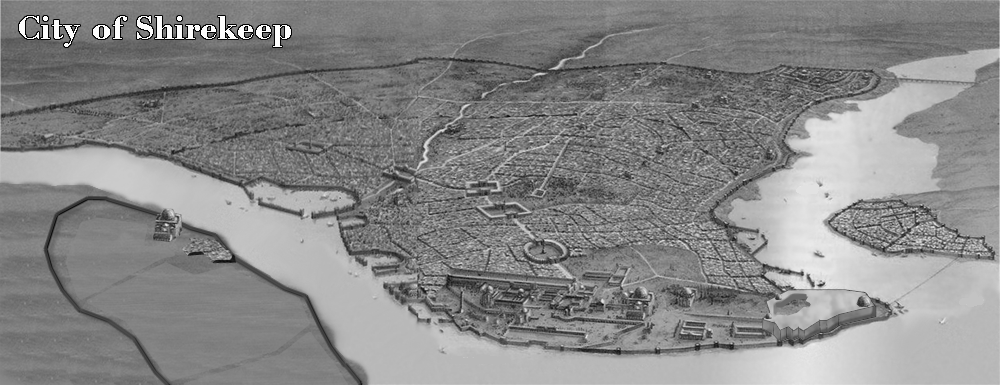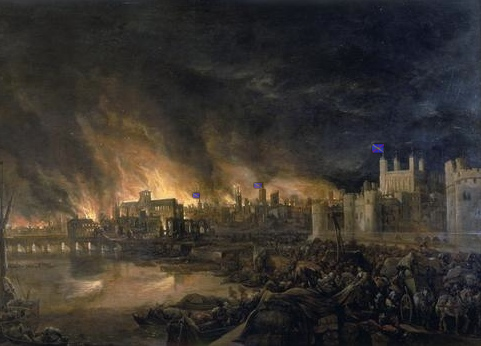Difference between revisions of "Shirekeep"
m (→History) |
|||
| Line 13: | Line 13: | ||
|pacoords = | |pacoords = | ||
}} | }} | ||
| + | |||
| + | '''Shirekeep''' is the capital and chief city of [[Shireroth]], with a history going back over 6,500 years. Shirekeep is a part of the [[Imperial County]], directly under the [[Kaiser]]. A [[Prefect]] (before 4290 ASC: Lord Mayor) can be appointed to handle city affairs. The last Prefect was a minor member of the [[Line of Win'Eth|House of Win'Eth]] who was executed for backing the wrong side in [[The River War|the River War]]. | ||
| + | |||
| + | Under [[Kaiser Dominus]], his predecessor [[Kaiser Hjalmar Redquill]], who managed to retire both alive and bodily intact, was appointed Prefect and Marquess of the city in 1642 to continue the programme of civic works and reconstruction he had begun whilst the reigning sovereign of the Imperial Republic. | ||
==History== | ==History== | ||
| − | |||
Although the origins of Shirekeep are shrouded in legend, most people believe that the city was founded by Kaiser [[Raynor I]] after his conquest of [[Brookshire]]. Raynor built the part of the city now known as "[[Raynor's Keep]]" as a fortress guarding the [[Elwynn (River)|River Elwynn]] and as a palace for himself and his successors; commoners and artisans settled to the east of the keep, on the Elwynn's west bank. During the reign of his successor, [[Raynor II]], the city expanded northward as Shirerithian forces fought off the Elw barbarians in the region surrounding the city. During Shirerithian expansion, many of the conquered peoples of the Shirerithian Empire immigrated to the city, creating the sprawling foreign quarters of the south, which were later destroyed by a fire. | Although the origins of Shirekeep are shrouded in legend, most people believe that the city was founded by Kaiser [[Raynor I]] after his conquest of [[Brookshire]]. Raynor built the part of the city now known as "[[Raynor's Keep]]" as a fortress guarding the [[Elwynn (River)|River Elwynn]] and as a palace for himself and his successors; commoners and artisans settled to the east of the keep, on the Elwynn's west bank. During the reign of his successor, [[Raynor II]], the city expanded northward as Shirerithian forces fought off the Elw barbarians in the region surrounding the city. During Shirerithian expansion, many of the conquered peoples of the Shirerithian Empire immigrated to the city, creating the sprawling foreign quarters of the south, which were later destroyed by a fire. | ||
Revision as of 13:48, 16 December 2016
Sxirosikx | |
| [[Image:{{{flag}}}|130px]] | |
| Population: | City within the Walls: 408,462 Greater Metropolitan Area: 8,270,000-14,025,646* *Seasonal fluctuations caused by migrant workers. |
| Predominant language: | English, Præta Sxiröþes |
|
| |
| Main roads: | Kaiser's Boulevard, Infernal Avenue, Nobles' Avenue, Heretic's Walk |
| Major districts: | Raynor's Keep, The Old City, Docklands, Underkeep |
|
| |
| Current mayor: | Audun Joel Ayreon-Kalirion (Prefect) |
| Map versions: | every map |
Shirekeep is the capital and chief city of Shireroth, with a history going back over 6,500 years. Shirekeep is a part of the Imperial County, directly under the Kaiser. A Prefect (before 4290 ASC: Lord Mayor) can be appointed to handle city affairs. The last Prefect was a minor member of the House of Win'Eth who was executed for backing the wrong side in the River War.
Under Kaiser Dominus, his predecessor Kaiser Hjalmar Redquill, who managed to retire both alive and bodily intact, was appointed Prefect and Marquess of the city in 1642 to continue the programme of civic works and reconstruction he had begun whilst the reigning sovereign of the Imperial Republic.
History
Although the origins of Shirekeep are shrouded in legend, most people believe that the city was founded by Kaiser Raynor I after his conquest of Brookshire. Raynor built the part of the city now known as "Raynor's Keep" as a fortress guarding the River Elwynn and as a palace for himself and his successors; commoners and artisans settled to the east of the keep, on the Elwynn's west bank. During the reign of his successor, Raynor II, the city expanded northward as Shirerithian forces fought off the Elw barbarians in the region surrounding the city. During Shirerithian expansion, many of the conquered peoples of the Shirerithian Empire immigrated to the city, creating the sprawling foreign quarters of the south, which were later destroyed by a fire.
Shirekeep has been burnt down several times, usually as a result of experiments or military drills gone awry, but occasionally during wars. The city suffered severe damage during the Mog Rebellion, and much of it was also burned down during the War of the Wylthean Succession. Most recently, parts of it have fallen into decay as the Kaiser's government lacks the funds needed to properly fully maintain the city.
The Great Fire of Shirekeep in 4030 ASC, during the reign of Kaiser B'Caw I and the secession of parts of Elwynn, proved to be a disaster for the capital: fire had destroyed the whole Foreign Quarter and a lack of funds avoided that houses were rebuild. Bureaucratic affairs and simply the discontent towards the foreigners who had lived in the southern quarters, led to the decision to use the land for other goals. Several Kaisers after B'Caw approved the plans to use the gained free lands for farmland, but ignored the need of defending it. It took until Kaiser Fish XII ordered the construction of the so-called Fishian Wall, in 4136 ASC, before the farmland was decently protected against possible treats. During Kaiser Gaelen IV's reign, Fort Tempus was built.
Following the dead of Gaelen IV, the Prefectoral era began for Shirekeep: Jonas Win'Eth became the ruler of Shirekeep and its surrounding lands. It saw also, for a moment, the threat of being attacked by the armed forces of its own Duke/king, the Rex of Raynoria, because of the city's support to Kaiser Cedris I. With His abdication of the throne, the danger was averted.
The condition of Shirekeep prior to Reconstruction
After the unfortunate business with the cabbage, subsequently immortalised in a doggerel of above average quality, and the slightly excessive amount of shelling that accompanied the otherwise, were it not for the staggering mortality, peaceful transition of the Imperial Throne into the possession of the House of Ayreon-Kalirion combined with a long period of neglect by successive Kaisers which saw redevelopment plans never leave the scratchpad, it would not be unfair to say that the august and imperial city of Shirekeep was in a terrible condition with only Raynor's Keep in any kind of presentable form. As far as the remainder was concerned, from the undredged docks to the collection of tents clustered around the ruins of the Palace of Zirandorthel that passed for the Landsraad, the city was a shambles, a collection of slums, weed choked fields and the jealously defended allotments of a few plucky subsistence farmers.
The average Shirerithian certainly needed a strong stomach to cope with the many smells that assailed him every time he went out of doors. The sewers had backed up at some point during the reign of Kaiser Trantor IV, who had suffered a breakdown in trust with the Landsraad and thus lacked the funds to undertake any remedial action. Apart from the traditional procession way down to Raynor's Keep, few of the roads marked on the map could be considered a street to speak of any more. Collapsed buildings, burnt out vehicles, shell craters and peasant hovels had encroached onto once broad avenues and thoroughfares, and throughout the green spaces of the city ran the innumerable ratruns of narrow tracks that were no more than channels of churned-up mud, and in all weathers stank with the slime of generations of filth and garbage daily renewed by the discharge from doors and windows. Only when the plague threatened to return was anything done about the piles of refuse that stood outside every front door. Each man was, on pain of incurring a cudgelling, required to burn his own rubbish at least three times a week. It was just as well that the city boasted so many open brown spaces in which to dispose of refuse. The city boasted a notional population of 14 million souls, most of these however were passing through in one sense or another, whether fleeing elsewhere or departing this mortal coil entirely. Those that remained resident in the city from one plague season to the next usually found accommodation in the ribats that were built within the skeletal frames of the ruined mansions of long vanished ancient houses, some of these ribats blossomed to the point where they became akin to vertical cities, walled unto themselves. Generally the disposal of the accumulations of filth was left to the elements, scavengers and the destitute poor.
Between those ribats, and the more salubrious and segregated mansions in gated communities corresponding to the Imperial States from which their owners - obliged to endure the capital for reasons of business or politics - hailed, there lived in the squalor of the slums all manner of destitute and disenfranchised souls - discharged soldiers, masterless men, beggars, thieves, whores, vagrants, cripples and tricksters. People such as these were not unique to Shirekeep, indeed they were found in all the major cities - Musica for instance was notable indeed famous for periodically burning down social housing under the guise of a religious observance - but in Shirekeep the absence of strong authority and its attraction for rich fools from all across the Imperial Republic lent itself to beggary, larceny and fraud on a grand scale. The denizens of the slums thus emerged by day and by night to practise their wiles upon the naive and law abiding in their midst, although since the rolling back of the charter in the name of State liberties, there was precious little law to abide by or enforce in the first place. The criminal fraternity was certainly better organised and motivated than the quasi-amateur sleuths of the Shirekeep City Guard.
There remained, with the exception of the dungeons beneath Raynor's Keep, two functioning prisons in Shirekeep to cope with its unruly citizenry. The first, 'Aurangzeb's Hospitality' was reserved for political prisoners, and had become so overcrowded since the reign of Kaiser Hjalmar, that some 'high-value' prisoners, such as Margana Win'Eth, were transferred under dubious circumstances to languish in Dragonsfold Gaol. The second, 'Loki's Jest' was a debtors jail hollowed out from underutilised portions of the Imperial Judex building. The wheels of justice ground away so fitfully slowly, if at all, that many prisoners perished before their case reached the docket.
The city then was bedevilled by the teaming multitudes of the indigent and a shattered infrastructure.
Fortunately, the monumental surge in refugees, prisoners of wars, cripples, invalids and other displaced persons in the wake of the River War, the Anarchy of Angularis and the Civil War in Goldshire, together with the quiet and patient observation of practices in Lichbrook and places further west supplied a solution.
The Cedrist temple on Proclamation Street in Raynor's Village was rebuilt by the Cult of Mors as a stepped-pyramid for the purpose of sacrifice - where those prisoners not ransomed within six months were duly sent. The first sacrifice each day took place at dawn and was dedicated to Viviantia to secure her blessing and to ensure that Atos would rise. Similarly the last sacrifice of the day would be made at dusk and would be dedicated to Mors in order to ward off the terrors of the night. The second sacrifice was devoured by the officiating priest and his fellow celebrants whilst the third sacrifice would be butchered, roasted and cut into portions for distribution amongst the notables of the city for their morning feasts. The remaining sacrifices of the day would be dispatched to the anatomists and resurrection men of Lichkeep so that they could ply their trade.
The eviscerated cadavers had autonomous locomotion restored by the backstreet resurrection men using various efficacious means adduced from the Lichport Grimoire, originally drafted by an agent of SAVAK as a means of destroying revenants but later turned to other purposes. These corpses, now remade in a crude shambling mockery of the living form, were further improved upon by teams of engineers and programmers before being returned by barge to the city for auction on the wharfside as 'revenant servitors', modelled in function - if not in form - upon those plucky and industrious zombots celebrated in verse elsewhere. In this manner a steady and dependable pool of indefatigable labour, in the form of uncomplaining, fundamentally honest, bio-mechanical constructs, accrued by regular increment thanks to the conduct of the hourly rituals of sacrifice officiated over by that noble order of priests whose lineage could be traced back as far as 5097 ASC.
It was unfortunate however, that some irregularity had crept into the process of conversion for the servitors. In addition to the regular supplements of minerals and oil based lubricants, the remade servitors also possessed a deep and abiding hunger for meat and offal. It was decidedly fortunate therefore that a fruitful relationship had already developed between the fighting pits, dissident rehabilitation centres, hospitals and dogfood canning factories of Kingsgate which was able to keep pace with the newly developed demand for produce in Shirekeep and to do so on an industrial scale. In this manner, the number of unfortunate biting incidents was kept to a minimum. It was also a good time for the sellers and manufacturers of muzzles.
Whilst the Imperial Court was undoubtedly pleased to see a new spirit of industry and enterprise return to the capital, the Kaiser, after catching a whiff of the great stench of this new an unregulated economy, held a discussion with the members of his advisory council, all of them clutching heavily perfumed pomades to their noses, and it was agreed that it might be 'a good thing' for the Landsraad to elect a new Prefect for the city who could reorganise the communes of the city and assert the grip of the Imperial Government upon Shirekeep before matters really got out of hand. The Red Elwynn after all was meant to be a metaphor, not a literal description.


